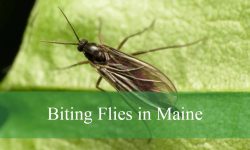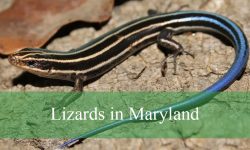Arizona’s deserts are home to some of the most fascinating yet dangerous bugs in North America. While many insects are harmless and even beneficial, a few species carry venom, strong bites, or disease risks that can pose real threats to humans and pets.
From the infamous Arizona Bark Scorpion to aggressive Africanized Honey Bees, encounters with these creatures are more common than many people realize. Their ability to hide in homes, gardens, and outdoor spaces makes awareness and identification especially important.
This guide highlights 10 of the most dangerous bugs in Arizona, with detailed descriptions of their appearance, venom, habitat, and behavior. Knowing what to look for is the first step to staying safe in the desert environment.
Types of Dangerous Bugs Found in Arizona
Arizona Bark Scorpion (Centruroides sculpturatus)
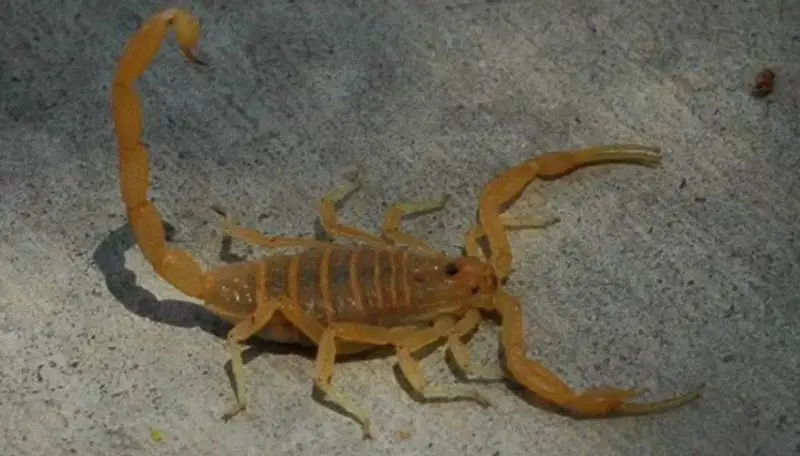
The Arizona Bark Scorpion is the most venomous scorpion in North America, and it is native to Arizona’s deserts. Adults measure about 2–3 inches in length, with a slender, pale tan body that blends easily with sand and dry wood. Unlike bulkier scorpions, its narrow pincers and thin tail help identify it.
Its venom is a powerful neurotoxin that can cause intense pain, tingling, numbness, muscle twitching, and temporary loss of motor control. In severe cases, victims may experience difficulty breathing, convulsions, and even life-threatening complications if not treated quickly. Children, the elderly, and those with weakened immune systems are at higher risk.
This scorpion thrives in desert scrub, rocky areas, and urban environments where it hides under rocks, bark, and debris. They are commonly found in Phoenix, Tucson, and surrounding desert communities. Because they can survive indoors, homeowners often encounter them in bathrooms, closets, and laundry rooms.
One unique trait of the Arizona Bark Scorpion is its climbing ability. Unlike most scorpions, it can scale walls, ceilings, and even hide inside shoes or clothing. This behavior makes it a particularly dangerous house invader.
They are nocturnal hunters, feeding on insects, spiders, and small arthropods. During hot summer nights, they become more active, and accidental stings occur more often when people walk barefoot or sleep near the floor.
Black Widow Spider (Latrodectus hesperus)
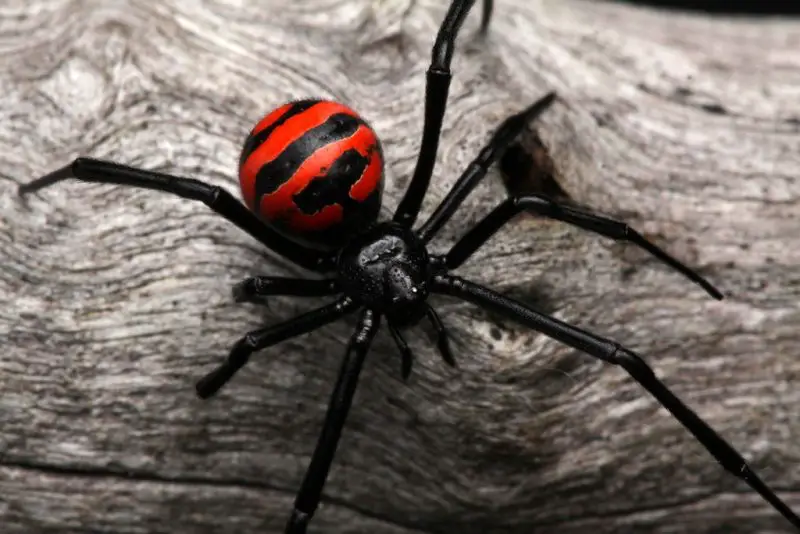
The Black Widow Spider is one of the most feared arachnids in Arizona. Females are jet black with a bright red hourglass marking on their abdomen, while males are smaller and less distinctive in color. Their messy, irregular webs are typically built close to the ground in sheltered areas.
Their venom contains a neurotoxin that affects the nervous system. A single bite may cause severe abdominal cramps, muscle pain, sweating, nausea, and restlessness. While rarely fatal with modern treatment, the symptoms can be excruciating and last several days.
These spiders prefer dark, dry, and undisturbed habitats such as garages, sheds, woodpiles, and crawl spaces. They are often encountered in suburban neighborhoods where human structures provide perfect hiding places.
Black Widows are shy by nature and bite only when threatened or accidentally pressed against the skin. Most bites occur when people reach into hidden spaces without gloves or disturb their webs.
Despite their reputation, Black Widows play an important ecological role by controlling insect populations. Still, their presence near homes is a serious concern, and caution is always recommended when working in outdoor storage areas.
Brown Recluse Spider (Loxosceles reclusa)
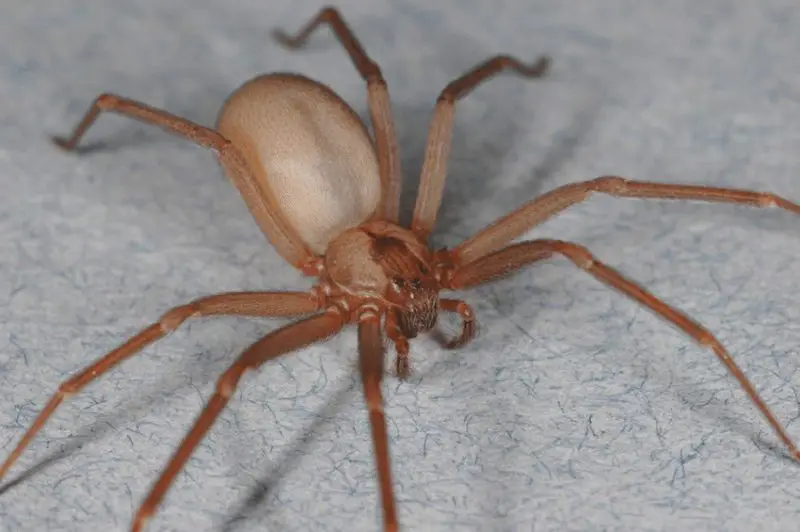
Although not as common in Arizona as in the Midwest, the Brown Recluse Spider occasionally appears in southeastern parts of the state. It is light to dark brown, with a violin-shaped marking on its back that gives it the nickname “fiddleback spider.”
The venom of the Brown Recluse is cytotoxic, meaning it destroys skin tissue. Bites may start as mild irritation but can progress into open sores, necrosis, fever, and in rare cases, systemic illness. While fatalities are uncommon, the wounds can be slow to heal and may require medical care.
They prefer dry, sheltered, and undisturbed environments such as closets, attics, boxes, and shoes. Their secretive behavior makes them difficult to detect until an encounter occurs.
Brown Recluses are nocturnal hunters that feed on insects and other small arthropods. They rarely bite humans unless trapped against the skin, such as when putting on clothing or shoes.
Because of their medical significance, suspected Brown Recluse bites should be evaluated promptly. Misidentification is common, so professional confirmation of their presence is important in Arizona households.
Africanized Honey Bees (“Killer Bees”)
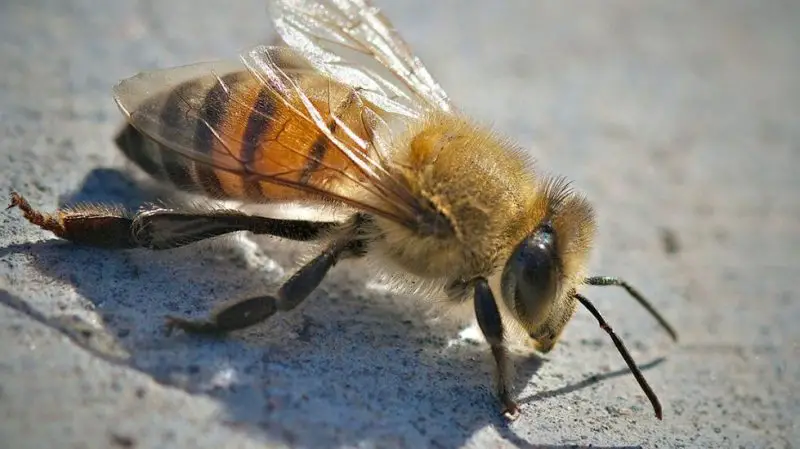
Africanized Honey Bees, often called “killer bees,” are hybrids that originated from African honey bees interbred with European honey bees. They closely resemble normal honey bees in size and appearance, making them difficult to identify without expert analysis.
The main danger lies in their behavior. Unlike regular honey bees, Africanized bees are highly aggressive and swarm in large numbers when disturbed. Multiple stings can deliver a dangerous dose of venom, even to healthy adults. For allergic individuals, a single sting may trigger anaphylaxis.
They thrive in Arizona’s warm desert climate and nest in a variety of places, including tree cavities, wall voids, sheds, and even underground burrows. Their ability to adapt to urban environments makes them a significant threat to residents.
These bees defend their hives far more vigorously than European honey bees, sometimes pursuing intruders for over 400 yards. This relentless aggression has led to numerous emergency situations when people or pets accidentally disturb a colony.
Despite their danger, Africanized Honey Bees still play an important role in pollination. However, professional removal is strongly advised if a hive is found near homes, playgrounds, or livestock areas.
Kissing Bugs (Triatoma spp.)
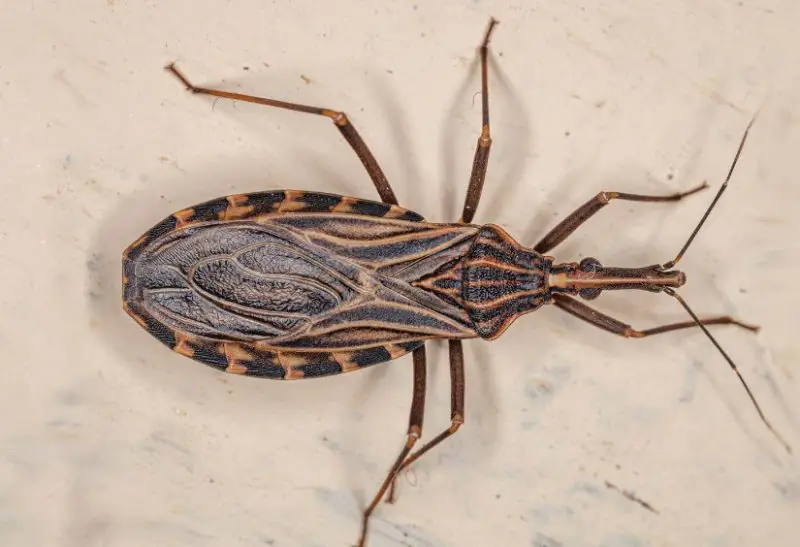
Kissing Bugs, also known as conenose bugs, are blood-feeding insects that have become a growing concern in Arizona. They are usually dark brown or black with orange or red stripes along their abdomen, measuring about 1 inch in length.
Their bites themselves are not extremely painful, but they pose a unique health risk. Kissing Bugs can transmit Chagas disease, caused by a parasite (Trypanosoma cruzi) that enters the body through contaminated bite wounds or contact with insect feces. This disease can damage the heart and digestive system over time.
They are nocturnal feeders, often entering homes during summer nights and biting sleeping humans around the mouth or eyes. Victims may wake up with swelling, redness, and itchiness where the bite occurred. Severe allergic reactions, including anaphylaxis, are possible in sensitive individuals.
Kissing Bugs typically live in rural and desert areas, often near rodent nests, kennels, or woodpiles. They are attracted to lights and may crawl indoors through open doors, windows, or cracks in walls.
Their secretive nature makes prevention challenging, but sealing entry points and keeping pets’ sleeping areas clean can help reduce the risk of infestation. Early detection and medical consultation are essential if Chagas disease is suspected.
Giant Desert Centipede (Scolopendra heros)

The Giant Desert Centipede is one of the largest and most intimidating arthropods in Arizona, often reaching lengths of 8 to 10 inches. It has a long, segmented body with a striking color pattern of reddish-orange head and tail segments, black body sections, and yellowish legs. Its strong jaws and speed make it an efficient predator.
The venom of this centipede is injected through sharp fangs located on its front legs. A bite causes immediate, burning pain, swelling, redness, and sometimes nausea or headache. While not fatal, the intense pain can last for hours and is considered more severe than most insect stings.
These centipedes are typically found in deserts, rocky outcrops, and beneath logs or stones. They prefer moist, sheltered areas during the day and emerge at night to hunt. Summer monsoon season brings them out more frequently, sometimes leading to encounters in homes.
Their diet consists of insects, spiders, small reptiles, and even rodents. They are highly aggressive hunters and rely on their venom to subdue prey quickly. Despite their ferocity, they usually avoid humans and only bite when handled or threatened.
Encounters are most likely outdoors at night or when overturning rocks and wood. Homeowners should exercise caution when gardening, camping, or hiking in desert regions where centipedes thrive.
Blister Beetles (Family Meloidae)
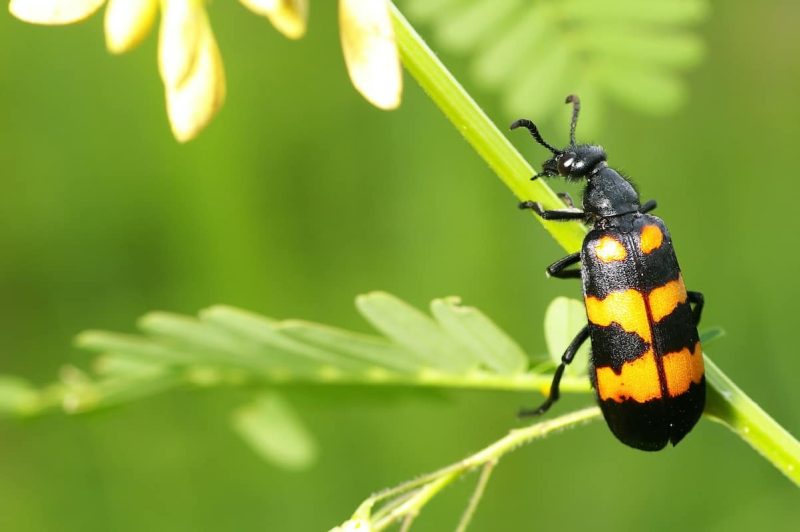
Blister beetles are medium-sized insects with elongated bodies, narrow necks, and soft wings. They can vary in color from gray and brown to striking black with orange bands, depending on the species found in Arizona. Despite their relatively harmless appearance, they pose a hidden danger.
These beetles release a chemical called cantharidin when threatened or crushed. Contact with this substance can cause painful blisters, burns, and skin irritation. If ingested, it can be highly toxic to humans and lethal to livestock, especially horses that eat contaminated hay.
Blister beetles inhabit grasslands, desert plains, and agricultural fields across Arizona. They are often seen in swarms during summer months, feeding on alfalfa, potatoes, and other crops. Their tendency to gather in large numbers increases the risk of accidental exposure.
They are not aggressive toward humans but become a problem when handled or accidentally pressed against the skin. Children are particularly vulnerable since they may pick them up without realizing the danger.
Farmers must take extra precautions, as blister beetles mixed into livestock feed can cause fatal poisoning. Preventing infestations in crops is a crucial step in minimizing risk.
Tarantula Hawk Wasp (Pepsis spp.)
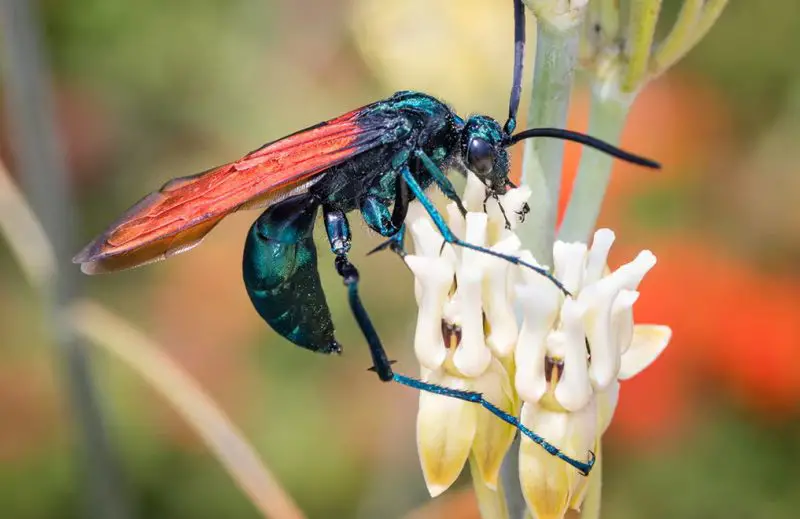
The Tarantula Hawk Wasp is an enormous wasp species easily recognized by its glossy black body and bright orange wings. Some individuals grow up to 2 inches long, making them among the largest wasps in the world. Despite their intimidating size, they are not naturally aggressive toward people.
Their venomous sting, however, is notorious. Ranked among the most painful stings known to science, it causes excruciating pain that can temporarily immobilize a person. Fortunately, the pain usually subsides within minutes and rarely causes long-term harm.
These wasps live in desert regions and open landscapes where tarantulas are found. Females hunt tarantulas by paralyzing them with a sting and dragging them into burrows, where they lay eggs that develop inside the spider’s body.
Although they are dangerous when provoked, Tarantula Hawk Wasps generally avoid humans. Most stings occur when someone accidentally steps on one barefoot or tries to handle it. Their large wings and loud buzzing often warn people to stay away.
Interestingly, adult wasps feed mainly on nectar from desert flowers, playing a valuable role in pollination. They are particularly attracted to milkweed and mesquite blooms during the summer.
Palo Verde Beetle (Derobrachus hovorei)
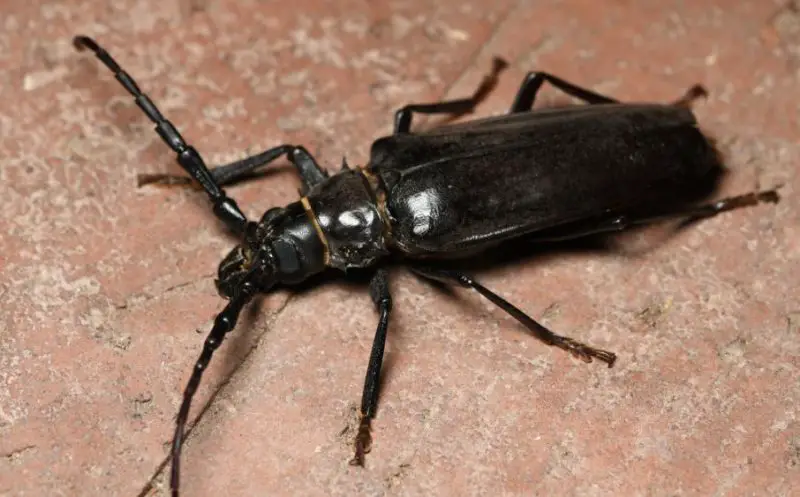
The Palo Verde Beetle is a massive wood-boring insect, measuring 3 to 4 inches long. With its dark brown to black body, long serrated antennae, and strong mandibles, it has an intimidating appearance that often frightens people.
Despite its size, the Palo Verde Beetle does not have venom or stingers. Its main threat comes from its powerful jaws, which can deliver a painful bite if mishandled. Though not venomous, the bite may break the skin and cause bleeding.
These beetles emerge during Arizona’s summer monsoon season, especially in July and August. They are strong fliers but often clumsy, sometimes crashing into walls, porches, or lights at night. Their attraction to artificial lighting makes them frequent visitors around homes.
Their larvae live underground for up to three years, feeding on the roots of Palo Verde trees, citrus, and other hardwoods. Adults, however, live only a few weeks and rarely eat. Their short adult lifespan is devoted primarily to reproduction.
While they look menacing, Palo Verde Beetles pose little long-term threat to humans. Still, their sheer size and sudden flights can be startling, leading many people to mistake them for dangerous invaders.
Assassin Bugs (Family Reduviidae)
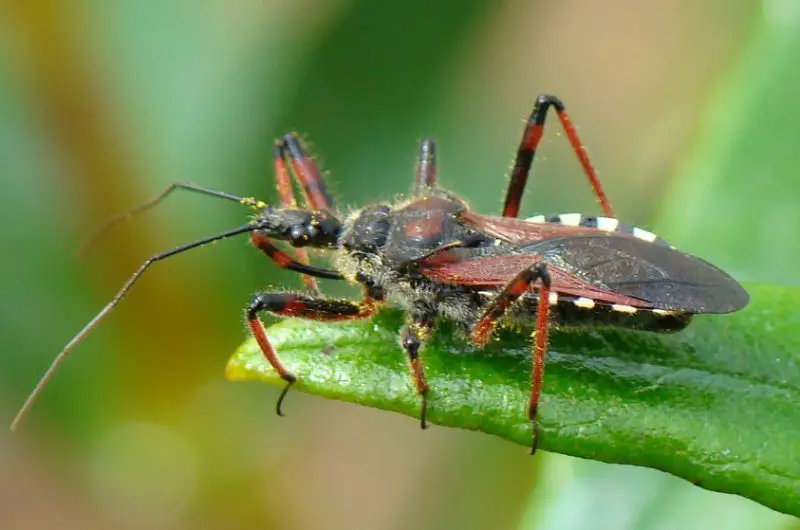
Assassin Bugs are predatory insects with elongated bodies, long legs, and a characteristic narrow head with a sharp, curved beak. Many species are dark brown or black, though some display bright warning colors. They are known for their stealth and powerful bites.
They use their beak to pierce prey, injecting saliva that liquefies internal tissues. While this adaptation is effective against insects, bites on humans are extremely painful and can cause swelling, redness, and allergic reactions.
Some assassin bugs, particularly kissing bugs (Triatoma species), pose an added risk because they can transmit Chagas disease. This serious parasitic illness can lead to heart and digestive system complications if untreated.
These insects are commonly found in Arizona’s desert and rural areas. They hide in cracks, woodpiles, animal burrows, or near rodent nests. Attracted to lights, they sometimes enter homes, where accidental bites occur during the night.
Although assassin bugs play an important role in controlling pests, their potential to bite and spread disease makes them one of Arizona’s most concerning insects. Avoiding direct contact and sealing home entry points are key protective measures.
FAQs about Dangerous Bugs in Arizona
What is the most dangerous bug in Arizona?
The Arizona Bark Scorpion is widely considered the most dangerous bug in the state. Its venom is the most toxic of any scorpion in North America, and stings can cause severe pain, numbness, and even life-threatening complications in vulnerable individuals.
Are Black Widow bites common in Arizona?
Yes, Black Widow bites do occur in Arizona, but they are not extremely common because the spiders are reclusive and only bite when threatened. Most encounters happen when people disturb their webs in garages, sheds, or woodpiles.
Can you die from a Brown Recluse bite in Arizona?
Deaths from Brown Recluse bites are very rare, but their venom can cause necrotic skin lesions and severe reactions. While Arizona is not the core range for this species, occasional sightings and bites have been reported in the state.
Do Africanized Honey Bees live in Arizona year-round?
Yes, Africanized Honey Bees thrive in Arizona’s warm desert climate and are active throughout the year. They are especially aggressive when defending their hives, which makes them more dangerous than regular honey bees.
How can you protect yourself from Kissing Bugs?
To reduce the risk of Kissing Bug bites, seal cracks in your home, use window screens, and keep outdoor lights to a minimum since they are attracted to them. Pets should also be kept in clean, secure sleeping areas to reduce exposure.
Are Giant Desert Centipede bites deadly?
No, Giant Desert Centipede bites are not considered deadly, but they are extremely painful and can cause swelling, nausea, and headaches. Medical attention is recommended if symptoms worsen or if the bite occurs in children or elderly individuals.
Why are Blister Beetles dangerous to humans and animals?
Blister Beetles secrete a chemical called cantharidin that causes skin blisters when touched. If accidentally ingested, they can poison humans and livestock, especially horses that consume contaminated hay.
How painful is a Tarantula Hawk Wasp sting?
The sting of a Tarantula Hawk Wasp is ranked among the most painful in the insect world. Victims often describe it as immobilizing pain that lasts for several minutes, though it is not typically dangerous or life-threatening.
Do Palo Verde Beetles bite people?
Yes, Palo Verde Beetles can bite with their strong jaws if handled, and the bite can be painful enough to break the skin. However, they do not have venom and are not considered medically dangerous.
Can Assassin Bugs really spread Chagas disease?
Yes, some Assassin Bugs, especially Kissing Bugs, can transmit Chagas disease through contaminated feces near bite wounds. While the disease is rare in the U.S., Arizona residents should still take precautions to prevent infestation.




